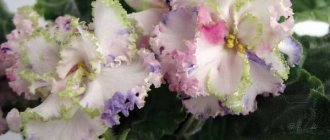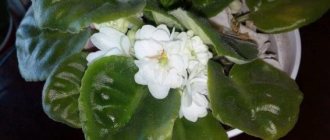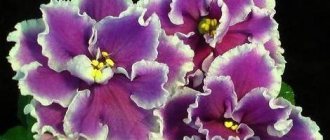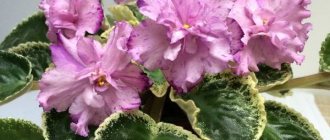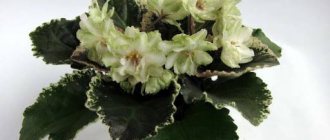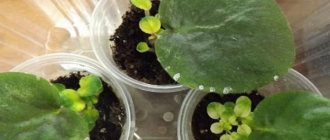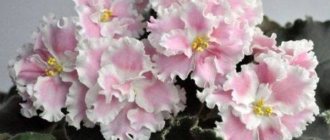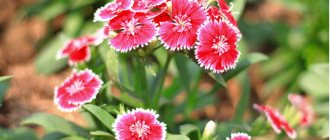Saintpaulias are one of the most popular indoor plants, and the number of varieties of this species is simply staggering .
Among them there are often similar in appearance and bearing completely different names, but there are also, on the contrary, not very similar with similar names.
bred by different breeders are a prime example of this . Below we will look in more detail at how the violet AB-Red Carnation and AB-White Carnation (Violet Plant), EK-Pink Carnation (E. Korshunova), LE-Neon Carnation (E. Lebetskaya) grow.
Each variety is unique and has its own characteristics in care and maintenance conditions . Compliance with which determines whether the color matches the varietal parameters, which is very important, especially for exhibitions.
Violet AB-Red Carnation: photo and description
Charming violet AB-Red Carnation.
AB-Red Carnation is an Uzambara violet, a genus of hybrid Saintpaulias belonging to the Gesneriev family. It was bred by a domestic breeder who goes by the pseudonym “Fialkovod” and all of whose varieties are signed with the capital letters AB before the name.
The bush is of standard size, the leaves are dark green , rounded with a heart-shaped base. The rosette is regular, but slightly inclined to lift the leaves upward. Flowers:
- Large;
- Terry;
- The color is rich red with a white border.
There are usually many peduncles and each has several flowers , so cap flowering is normal for this variety.
Important! With a strong increase in temperature and brightness of lighting, the white edging decreases and may disappear completely.
Care
variety is more unpretentious in care than other Saintpaulias:
- Watering and fertilizing:
- In the tray (under the leaves) - a pot or several are placed on the tray at once and water is added to the tray (under the leaves on the ground), after watering, the excess water is drained from the tray after 20 minutes. Watering frequency approximately: Once a week – in summer;
And once every one and a half to two weeks - in winter.
For fertilizing, use a concentration of fertilizers half that recommended , and fertilizing itself is carried out through watering, after about two weeks in summer and three to four in winter;
This variety needs to find suitable conditions.
- In summer – 22-24°C, daylight hours at least 12 hours;
Reviews
Victoria. “Very bright and fluffy beauty. The socket has formed correctly. The flowers pleased me from the third bloom; before that they were not so large and there was no cap of flowers. At first I couldn’t understand why there was no white border, but by reducing the brightness of the lighting before flowering and moving it a little to a cooler place, I got a beautiful, almost uniform border.”
Saintpaulia flowers resemble fluffy skirts.
Anna. “I was pleased with the purchased leaf with its quick rooting and three children at once. After the first flowering I was a little disappointed, the flowers were completely red, without a border and semi-double. I decided to wait a second time and did not regret it. The second bloom was capped, and the flowers were double and with a beautiful white border.”
Useful video
Watch the video to see what the AB-Red Carnation violet looks like:
Reviews
Olga. “SM-Kalina Red – love at first sight, rich color, neat rosette with bright flowers. I saw this Morevsky variety at an exhibition, and for three years now the violet has been among the favorites in my collection.”
Elena. “The variety reproduces quickly, the cutting produces many children at once, in other respects, like many Morevsky varieties. It begins to bloom early, so young starters have to remove flower stalks so that they gain green mass instead of wasting energy on flowering. The variety blooms constantly."
Violet attracts many gardeners.
Natalia. “The name of the violet speaks for itself. The color is rich, there are many colors. My rosette has grown to 35 cm. In the summer, the green edging disappears, and already in the autumn flowering it appears again. I grow it on eastern windows, in the summer I have to shade it from the sun.”
Violet Pink carnation (E. Korshunova)
EK-Pink carnation is a Saintpaulia bred by breeder E. Korshunova . This variety belongs to the genus of hybrid Saintpaulias, the Gesneriev family.
Delicate violet Pink carnation.
The rosette is large with fleshy, dark green leaves , slightly curled downwards. Flowers:
- Large;
- Semi-double and terry;
- Three to five are placed on each powerful peduncle.
There are many flower stalks, usually blooming in a cap or bouquet .
Care
The variety does not require special care .
Each Saintpaulia requires certain care.
| Irrigation type | In the tray (under the leaves) — flowerpots with plants are placed on a stand up to two cm deep. Water is poured into the tray (under the leaves). After watering, excess water is drained after 20-30 minutes. — The frequency of watering depends on the need (when the soil dries out) in the summer about once a week, in the winter – one and a half to two weeks. | Wick - a wick is placed in the pot, it is taken out through the drainage hole and placed in a container with water, which is placed under the flowerpot. — Water is constantly in the container. |
| Primer (recommended) | — Ready-made substrate for violets (Saintpaulia) is well suited for these types of watering. — The mixture can be made at home from peat, leaf soil, perlite and sphagnum moss in a ratio of 3/3/3/2. | — A mixture of peat and perlite in a ratio of 1/1. — Other types of soil are also suitable, but may become waterlogged with such watering. |
| Lighting and temperature | Summer – 22-24° C. Daylight hours should be more than 12 hours (bright lighting but without direct sunlight) | |
| Winter – 16-18° C. Daylight hours are about 8-10 hours. | ||
| Spring, autumn - the temperature changes gradually, as does the length of daylight hours. | ||
| Feeding | — Mineral fertilizers are applied through irrigation. About once every two weeks in the summer, and once every three to four weeks in the winter. — It is recommended to reduce the concentration by half from what is indicated in the instructions. | — Subcortex is constantly added to the water. — The concentration should be 7-8 times less than that recommended by the manufacturer. |
After proper care, Saintpaulia will reward you with good flowering.
Advice! By changing the temperature and brightness of the light, you can slightly change the color of the flowers, from pale pink to almost white in dark places and at low temperatures, and dark pink with plenty of light and rising temperatures.
Reviews
Christina. “I bought a leaf of the EK-Pink Carnation variety and received two babies at once. It’s good that I didn’t give one away and received two carved rosettes. From the first flowering, one of them went clearly according to the variety, pink, double, only the cap flowering turned out to be the third time. But the second one gave a beautiful sport, double flowers and very beautiful pink and white with a small light green border. In the second flowering, the color was repeated, and there were enough peduncles and buds for a cap.”
Olga. “I bought a blooming rosette of a beautiful violet pink carnation. With each subsequent flowering it produced a persistent bouquet and was pleasing to the eye. Unfortunately, the bush did not survive the hot summer, but the leaves rooted in the spring pleased several children at once, some of whom eventually became sports.”
Useful video
Find out in the video how the Pink Carnation violet blooms:
Transplant rules, rejuvenation
It is better to carry out replanting by transferring an earthen clod, with partial replacement of the soil . An adult rosette is replanted every six months, usually after the second flowering. Young seedlings are transplanted as their roots entwine the soil.
Adult rosettes are rejuvenated every two years . For this:
- Cut off the bare stem;
- Remove unnecessary old leaves from it;
- And they root in a new substrate.
For better rooting, the plant is placed in a greenhouse until a new root system forms.
ADVICE! If you are growing a Viburnum Red seedling on a windowsill, then the ideal distance from the window is about 25-30 cm. By placing it at this distance, the variety will receive enough natural light, and will also not freeze in winter and during the cold season.
Violet AB-White Carnation
Saintpaulia AB-White Carnation was bred by a breeder under the pseudonym “Violet Grower” , all varieties of which are signed with the capital letters AB before the name of the variety. Uzambor violet belongs to the genus of hybrid Saintpaulias, the Gesneriev family.
Fantastic violet AB-White carnation.
Medium sized bush, leaves :
- Light green;
- Rounded;
- And they have a tendency to lengthen the petioles.
Flowers:
- Large;
- Strongly terry;
- White with a heavily ruffled pink border.
From one to three buds are formed on each peduncle ; there can be many peduncles and this ensures cap flowering.
Care
Attention! AB-White carnation is very sensitive to temperature and lighting.
Like all Saintpaulias, she prefers bright diffused light , without direct sunlight, but it is important not to overdo it with natural lighting, because this can lead to darkening of the flowers.
Daylight hours vary from 8-10 hours in winter to 12-14 hours in summer.
The temperature should be in the range of 16-24°C without sudden jumps, the lower limit is for the winter dormant period, and the upper limit is for summer and the flowering period; it is gradually changed in the off-season.
If the temperature rises excessively during flowering, the color of the flowers may change, as well as with an excess of light in the dark direction.
Each gardener chooses the type of watering for himself, and the choice of soil and fertilizer directly depends on this:
- To pallet – one or more individuals are placed on trays up to 2 cm deep. Water is poured into this container and the flower is allowed to drink for 20 minutes, after which the excess water is drained. With this type of watering:
- Fertilizers are applied once every two to three weeks;
The concentration of fertilizing is reduced by half from that recommended by the manufacturer.
- Under the leaves , water is added to the ground, the excess flows off and after a while it must be drained. The frequency and concentration of fertilizers, as well as the soil mixture, are similar to the previous option;
- Wick - place a wick in the pot, lower it into the lower, additional container through the drainage holes. The amount of fertilizer is calculated in proportion to 1/8 of the recommended dosage, and the plants are watered with this water constantly. For this type of irrigation, it is recommended to make a substrate of peat and perlite in a 1/1 ratio.
The soil is suitable ready-made for violets or a mixture of peat, perlite and leaf soil in equal proportions with the addition of sphagnum moss, the amount is adjusted depending on air humidity;
Reviews
Faith. “When buying a baby, I coveted the name White Carnation, I really love white Saintpaulias, when it bloomed I was a little disappointed, but also pleased at the same time. The positives were:
- Abundance of flowering (especially the first one);
- Evenness of the rosette (even with natural lightening);
- The splendor and elegance of flowers.
The downside for me was the pink border, although it is very beautiful and fits harmoniously, but I love pure white.”
Natalia. “I was pleasantly surprised by the first flowering of the starter I bought. The flowers are very large, double with a beautiful color that fully corresponds to the varietal characteristics. On the second flowering, the rosette pleased me even more, producing many peduncles and buds. After the flowers bloomed, it turned out to be a beautiful hat.”
Useful video
Find out in the video how the White Carnation violet grows: Watch the video how the White Carnation Saintpaulia develops:
Violet Neon carnation (E. Lebetskaya)
LE-Neon carnation belongs to the Uzambor violets, a genus of hybrid Saintpaulias, of the Gesneriev family. The variety was recently bred by domestic breeder E. Lebetskaya.
Beautiful violet Neon carnation.
The rosette is compact and medium in size, but under certain circumstances it is prone to elongation of leaves . Flowers:
- Large;
- Semi-double with ruffled edge.
Saintpaulia color
- Deep pink;
- Close to fuccia;
- A white-light green border may appear along the edge.
Important! Usually it forms many peduncles and each has three to four buds, which ensures flowering in a cap.
Care
Neon carnation is no more demanding to care for than other varieties. Lighting should be plentiful but without direct sunlight. The temperature is maintained within 16-22°C in accordance with the season.
The soil is chosen at your own discretion, but it is recommended to use a ready-made substrate for Saintpaulia or a mixture:
- Peat/perlite/leaf soil/sphagnum moss in the proportion 1/1/1/0.5-0.8;
- And also peat/perlite in a 1/1 ratio (ideal for wick irrigation).
Watering is carried out in one of three ways :
- into a tray - into a container where pots with violets are pre-installed, up to 2 cm deep. After 20 minutes, the remaining water is drained. Fertilizers are applied through irrigation and the concentration is halved from that recommended by the manufacturer;
- Under the leaves - it is recommended to place the pots on pallets, and pour water onto the ground, avoiding contact with the leaves. After some time, excess water is drained from the pan. Fertilizers are applied as in the previous method;
- Wick - water is poured into a container, and a wick passed through the pot is lowered into it. Fertilizers are constantly added to the water, and their concentration is reduced by 7-8 times the recommended value.
Reviews
Many gardeners want to get this variety for themselves.
Catherine. “I bought a baby Neon Carnation. It grew quite slowly, but I think the problem is in the conditions of care, because all my flowers are very slow. The first flowering pleased me; the color was simply beautiful, rich and at the same time delicate. The border along the corrugated edge looks very impressive.”
Alina. “Unfortunately, the purchased rosette disappeared immediately after flowering. I really liked the color and shape of the flowers, as well as the shape of the rosette itself. The good news is that after the purchase I cut off a few extra sheets and decided to root them. Each gave from two to four children, and now I will have this beautiful flower.”
Reproduction methods
Saintpaulias are often propagated by leaf.
The variety reproduces:
- Stepchildren;
- Cuttings;
- Peduncles.
Most often, violet growers propagate this variety by planting cuttings in a substrate; a lot of children are obtained from one cutting . One cutting can produce up to 7-10 children.
